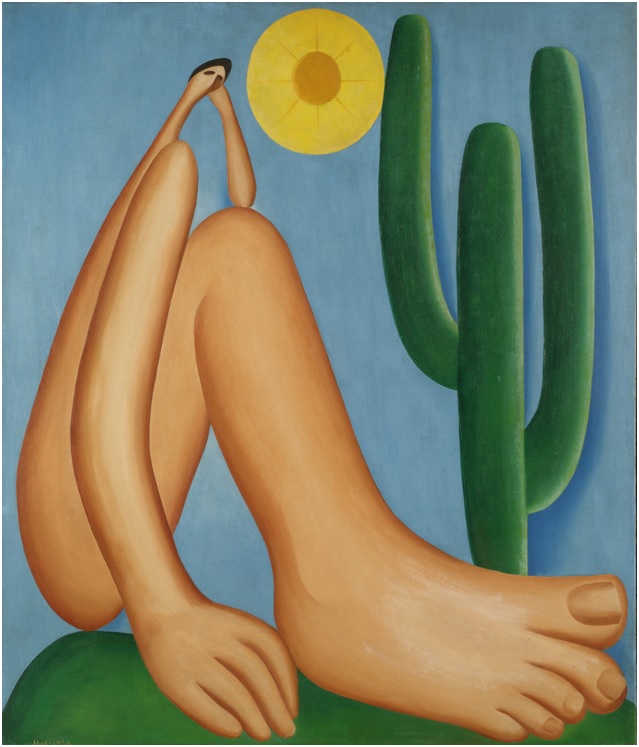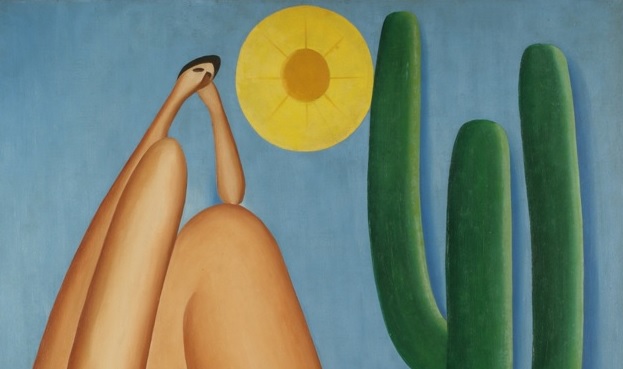
The work "Abaporu" (1928), Tarsila do Amaral, considered the first lady of the national modernism, will be at the Museum of art of River-SEA only until next Tuesday, day 30 August. The frame, that is part of the acquis of the Malba, in Buenos Aires, He returned to Rio de Janeiro for the first time since the beginning of the 20th century to integrate temporary shows "The color of Brazil”, at SEA until the day 15 January 2017.
About the exhibition
The exhibition the color of Brazil traces the trajectory of brazilian art from the colonial period to the 21ST century. The show brings together more than 300 pieces from Argentina, of Mexico and other 12 institutions throughout Brazil, which ceded part of their holdings to the most complete anthology of color ever presented in Rio de Janeiro.
The course consists of masterpieces ranging from Frans Post – one of the most important Dutch artists, that in the 17th century participated in expedition by northeastern Brazil – the Tarsila do Amaral, considered the first lady of the national modernism and author of Abaporu (1928) and Cannibalism (1929), world-famous paintings that return to the city for the first time since the beginning of the 20th century. The public will also have the opportunity to enjoy the praise of beauty in colors of Eliseu Visconti and Beatriz Milhazes.
The exhibition was divided into three galleries. The first of these, titled the transformation of light and of the ecological environment in color, is dedicated to the synthetic vision of the landscape. Portraits, landscapes and still lifes yield space for a better selection of Impressionism in Brazil, While the philosophical basis of the change of concept can be understood from the challenge launched by Graça Aranha, that encouraged the artists in the transformation of light into color and Brazilian ecological environment in plastic sensations. In the same environment, the chronology follows to show modernity introduced by Anita Malfatti, Guignard, Goeldi, Portinari, Ismael Ney, Lasar Segall, Antonio Gomide and Flavio de Carvalho, among others.
The second room, Modernity and Autonomy of art, It is formed by several significant cores. The group formed by Henrique Bernardelli, Bruno Lechowski, José Pancetti, Milton Dacosta, Quirino Calvo and Joaquim Tenreiro will picture the emancipation of regionalism for the desire to paint. In the same space, There are also formed by the concretists cores de são Paulo – Waldemar Cordeiro, Lothar Charoux, Geraldo De Barros, Hermelindo Fiaminghi, Luis Sacilootto and Judith Lund; the neoconcretos – Franz Weissmann, Hélio Oiticica, Lygia Pape, Coal Aluisio, Decio Vieira, Willys de Castro, Barsotti and Osmar Dillon; the gestural-Flag, Shiró, Tomie Ohtake, Mabe and Iberê Camargo; as part of the color scene in Rio formed by Eduardo Sued, Manfred Souzaneto and Gonçalo Ivo.
In the third and last room, Opinion, Tropicalia, Generation 80 and color of the 21st century, the focus becomes the color of the river, from movements occurred in the city: the Opinion shows and Tropicalia, the Experimental Room of MAM and Generation 80. To portray the extent of color theme in Brazil for the past six decades, a meeting of the works of Anna Maria Maiolino, Antonio Dias, Carlos Vergara, Roberto Magalhães, Rubens Gerchmann, Wanda Pimentel, Tunga, Anna Bella Geiger, Katie van Scherpenberg and José Maria Dias da Cruz, teachers at the school of Visual Arts of Parque Lage. Reaching the 21ST century, a review of the idea of "national", It has its largest flag icon. The exhibition incorporates the implications and political projects of color today, inquiring if there was an Afro-Brazilian art color.
The color of Brazil has curated by Paulo Herkenhoff and Marcelo Campos. The achievement is the Odeon Institute/Museu de Arte do Rio; production of Maria Clara Rodrigues, the Imago Art Office; with Leila architecture Scaf Rao; and graphic identity of Fernando Milk.
The Museu de Arte do Rio
The MAR is a space dedicated to art and visual culture. Installed in Praca Maua, occupies two adjacent buildings: an older, lying and eclectic style, which houses the Exhibition Hall; another younger, Modernist, Look where the school's work. The architectural design unites the two buildings with a fluid concrete cover, which refers to a wave - a trademark of the museum -, and a ramp, where visitors come to the exhibition spaces.
An initiative of Prefeitura do Rio in partnership with Fundação Roberto Marinho, the sea has activities that involve collecting, registration, search, preservation and return of cultural property to the community. Proactive support space education and culture, the museum was born with a school - the School Look -, whose proposal is innovative museological: foster the development of an educational program of reference for actions in Brazil and abroad, combining art and education from the curatorial program that guides the institution.
Sign up to receive Event News
and the Universe of Arts first!
The museum has the Globe Group as maintainer, the BNDES as exhibition supporter, Dow and Banco Votorantim as supporters of the School the look, the Ita as display copatrocinador 18th Century River, When the river turned Capital, TIM as supporter of the SEA music project, and the Grupo Libra as supporter of educational visits. It also has the support of the Government of the State of Rio de Janeiro, and implementation of the Ministry of culture and the Federal Government of Brazil through the Federal law of incentive to culture. The management is left to the Odeon Institute.
Service MAR - Museu de Arte do Rio
Entrance: R$ 10 The R $ 5 (half price) - People with up 21 years, private school students, university, disabled people and public servants of the city of Rio de Janeiro. The sea is part of the Carioca Program Pays Half, offering half price to locals and residents of the city of Rio de Janeiro in all cultural institutions linked to City Hall. Present a document proving (identity, proof of residence, water bills, light, pay phone with, tops, three months of issue) and remove your ticket at the box office. Payment by cash or card (Visa or Mastercard).
Single Ticket: R$ 16 – R$ 8 (half price) locals and residents in Rio de Janeiro, on presentation of supporting documentation or proof of residence. Supporting documents will be considered those that contain the birthplace, such as RG, driver's license, portfolio of work, Passport etc.. Will be considered proof of residence titles of collection with a maximum 3 (three) months of issue, as water services, light, landline or natural gas, duly accompanied by official document of identification with photo (RG, driver's license, portfolio of work, Passport etc.) of the user.
Policy free: Pay no entry-on presentation of evidentiary documentation – students from public (teaching elementary and middle), children up to five years or people from 60, public school teachers, employees of museums, groups in situations of social vulnerability educational visit, Neighbors of the sea and tourist guides. Tuesdays admission is free to the general public. On Sunday admission is free for holders ofMuseums Passport Cariocas you still don't have the stamp of the SEA. On the last Sunday of the month the Museum has free entry into all through the project Sunday at sea.
Tuesday to Sunday, das 10h às 17h. On Mondays the museum closes to the public. For more info, contact by phone (55 21) 3031-2741 or visit www.museudeartedorio.org.br.
Address: Praca Maua, 5 - Center.

